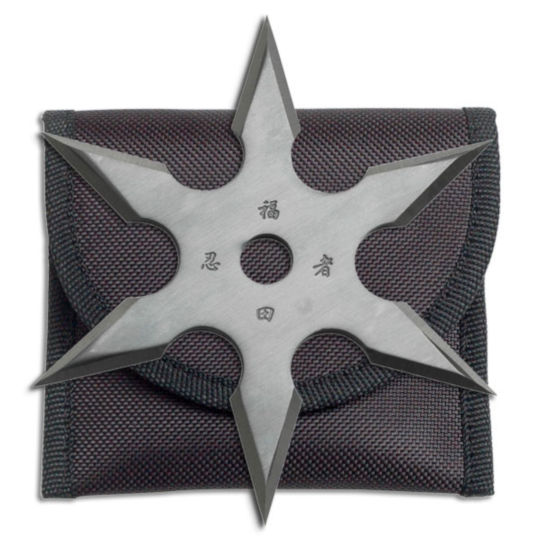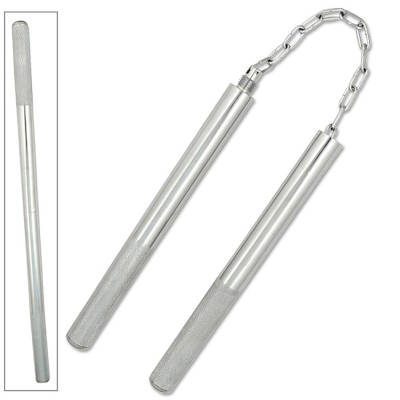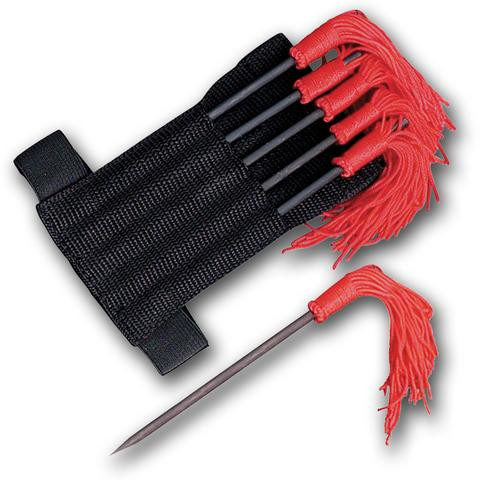Ninja Weapons List
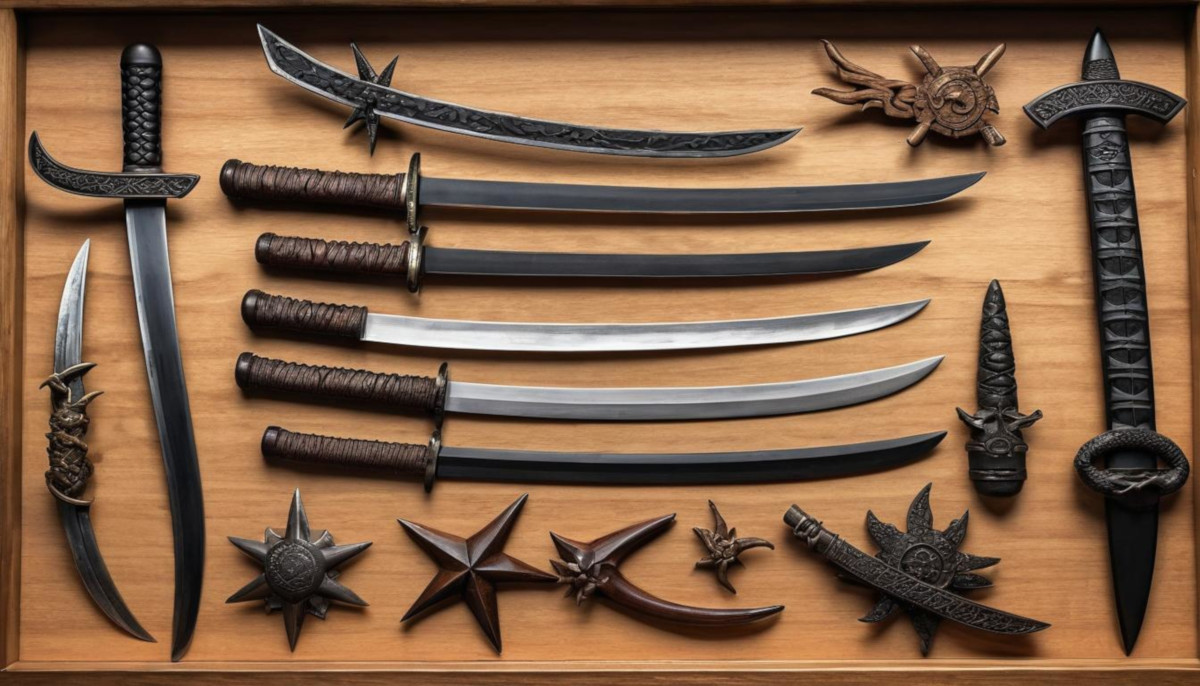
Ninja weapons, ranging from shurikens to katanas, are an artistic blend of tradition and function that has stood the test of time. These formidable tools were not only effective in battle but also versatile; for instance, the kunai could be used as a climbing aid or for prying apart objects. But what you might not realize is that these weapons also showcase a profound level of intricacy, particularly those with blades - the Katana's swift draw and attack, for example. So let’s start our journey by delving into this fascinating world...
Some common ninja weapons on our list include shuriken (throwing stars), kunai (multi-purpose tools), kama, sai, bo staff, and the ninjato (ninja sword). Each of these weapons has a specific historical context and unique characteristics that make them iconic in the realm of ninja weaponry.
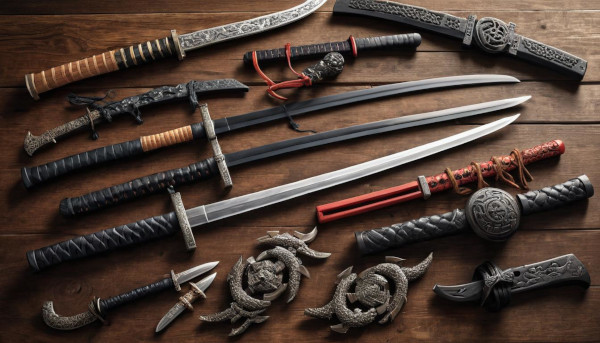
Traditional Ninja Weapons: A Detailed List
When we think of ninjas, their weapons are just as iconic as their stealth. Traditional ninja weapons were meticulously designed for a range of purposes and played a crucial role in executing covert missions and self-defense. Let's take a closer look at some of these iconic ninja armaments.
Shuriken
The shuriken, commonly known as ninja throwing stars, were among the most well-known weapons in a ninja's arsenal. These star-shaped throwing weapons were used for distraction, creating noise to divert attention, and for long-range attacks. Contrary to popular belief, shurikens were not primarily intended to cause physical harm but rather to create opportunities for escape or advancing undetected.
Shurikens came in various shapes and sizes, some with sharp edges and others with blunt tips—this variety allowed ninjas to adapt their approach based on the target and mission at hand. Expertly crafted for easy concealment, shurikens were an indispensable tool in a ninja's toolkit.
Kunai
Kunais were multi-purpose tools that resembled daggers—known for their sturdiness and versatility. Aside from being used as a weapon, kunais could be employed for climbing, prying, or even as a basic tool for handling daily tasks. This adaptability made kunais one of the most indispensable tools for ninjas during their secret missions.
Kunais often had a leaf-shaped blade and a handle with a ring on the end—allowing them to be easily hung from ropes or trees for convenient access. Their dual functionality meant that they were invaluable in both offensive and non-combative scenarios.
Katana
The katana is a traditional Japanese sword characterized by its distinctive appearance and deadly cutting power. Ninjas were skilled in using the katana with precision and agility in close combat situations. Though commonly associated with samurai warriors, the katana was also an essential weapon for ninjas due to its lethal effectiveness.
The curved and slender blade of the katana enabled swift strikes and parries—ideal for fast-paced combat where agility was key. Its design allowed ninjas to execute precise slashes with minimal effort, emphasizing precision over brute force.
Nunchaku
Nunchakus were composed of two sticks connected by a chain or rope—a flail-like weapon used for self-defense and attack as part of the ninja's repertoire. While requiring advanced skill to wield effectively, the nunchaku was an adaptable weapon suited for both defensive maneuvers and offensive strikes.
Its versatile nature made it unpredictable in combat, providing ninjas with the element of surprise—particularly effective in close-quarter confrontations, enabling rapid shifts between offensive and defensive tactics.
Kusarigama
The kusarigama was a sophisticated weapon comprising a sickle attached to a metal weight by a chain. This intricate design offered ninjas immense flexibility in combat scenarios—seamlessly transitioning between long-range attacks using the weighted end and close-quarters combat utilizing the sickle.
Ninjas leveraged the kusarigama's distinctive duality to disorient opponents—shifting seamlessly from ranged maneuvers to swift, close-range strikes; making it one of the most versatile weapons in the ninja arsenal.
As evident from this comprehensive exploration of traditional ninja weapons, each weapon served specific tactical purposes, showcasing the ingenuity of ninjas in crafting versatile armaments aligned with their stealthy operations.
The Intricacies of Ninja Bladed Weapons
Bladed weapons were crucial to a ninja's arsenal, each serving specific purposes that catered to the essence of stealth and precision in their art. The choice of weapon often depended on the context, mission, and individual preference of the ninja.
The Katana, a long, distinctive sword synonymous with Japanese culture, is undoubtedly iconic. With its curved blade and long grip, it was known for its unparalleled sharpness and cutting power. The katana exemplified dexterity and efficiency, designed for swift draws and precise, lethal strikes.
In contrast, the Ninjato, another revered bladed weapon, featured a straighter blade compared to the katana, making it an effective tool for discrete and close-quarters combat. Tailored for precise strikes and quick maneuvers, it was ideal for situations where stealth was paramount.
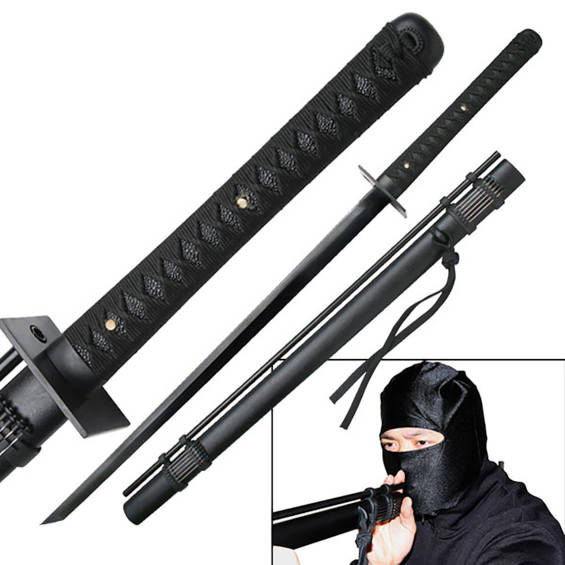
Next comes the Tanto, a multifaceted weapon not confined to its diminutive size. It served as an indispensable close combat weapon due to its ability to be concealed easily. Made for puncturing armor in battle and efficiently dispatching sentinels during infiltration missions, this knife or dagger bore immense significance in the ancient hierarchy of ninja weaponry.
The Kunai was adeptly repurposed by the ninja as a covert tool, employed for scaling walls, digging small holes for traps, or serving as a close-range offensive implement when needed. This adaptability highlights an important aspect of ninja philosophy - resourcefulness.
Finally, we have the shuriken—commonly known as throwing stars—which held a special place amidst other bladed weapons. These specialized stars were compact and discreet, encompassing multiple sharp edges that allowed them to serve as both distance weapons when thrown or as hand-to-hand combat tools.
So intertwined with every facet of a ninja's life were these blades that even beyond their functional value in combat, they reflected both skillful craftsmanship and spiritual significance.
Discovering the diverse tactical uses of these traditional weapons laid the groundwork for developing the advanced techniques seen in ninja throwing weapons. Understanding their efficiency holds significant importance in broadening our appreciation of these silent warriors' methods.
The Efficiency of Ninja Throwing Weapons
Throwing weapons were crucial to the arsenal of any self-respecting ninja, as they allowed them to strike from a distance or even distract their enemies. Shuriken and Kunai were among the most renowned throwing weapons, each with its own unique advantages and applications.
Shuriken: Precision Instruments of Distraction and Harm
Shuriken, also known as "throwing stars," were the quintessential ninja projectile weapon. These small, concealed metal objects were perfect for clandestine operations, easily hidden on a ninja's person. While often depicted as having razor-sharp edges and piercing points, which some variations certainly did, shuriken actually ranged from simple flat discs to elaborately designed multi-pointed stars. The versatility of shuriken further emphasized how ninjas valued these tools—some were even fitted with smoke bombs or hidden blades.
Throwing shuriken required precision and practice, as they could inflict damage from a distance when aimed accurately. However, their primary purpose was not always lethal—shuriken would often be used to create diversions or distract adversaries, allowing ninjas to evade capture or initiate a surprise attack.
Kunai: A Multipurpose Tool Turned Lethal Weapon
Kunai held special significance in the ninja's toolkit. Initially employed as multipurpose farming tools, kunai were repurposed as dual-edged daggers that adapted seamlessly into the warfare of ancient Japan. Their sturdy construction made them suitable for close combat, but their aerodynamic design also allowed them to be hurled effectively over short distances.
Used primarily for close combat or thrown as a projectile, kunai served various tactical purposes. They could be embedded into surfaces to create footholds for climbing, used in hand-to-hand combat due to their simple yet effective design, and served as improvised hooks or levers when required.
Kunai's adaptability and offensive capabilities made them an essential part of a ninja's tactics—whether for confronting adversaries head-on or escaping from perilous situations by creating strategic diversions.
The effectiveness of these throwing weapons underscored the skill and resourcefulness of ninjas. Understanding their proficiency enhances our appreciation for these ingenious tools and the martial artistry they embodied.
Overview of Modern Ninja Weapons
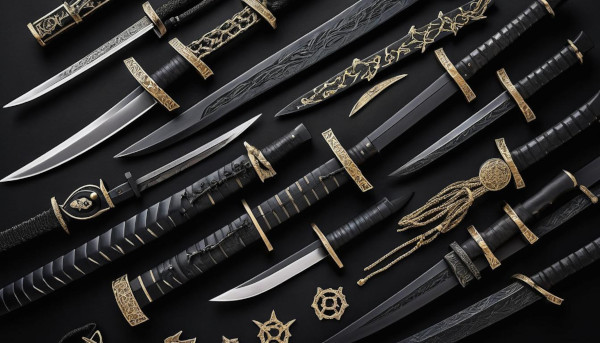
In today's modern world, new threats and dangers call for innovative solutions in self-defense, and ninja weapons have evolved to meet these challenges. Let's take a look at some of the key modern ninja weapons and understand their important roles in personal safety.
Tactical Pens
At first glance, a tactical pen may seem like an ordinary writing tool, but it is designed for far more than jotting down notes. Constructed with durable materials, it features a hardened tip that can be used as a last-resort self-defense weapon. The pointed end can apply significant force to sensitive target areas on an assailant's body, providing a means of defense in close combat situations. Many tactical pens also come equipped with features such as glass breakers and handcuff keys, making them versatile tools for any unexpected situation.
Tactical Flashlights
More than just illuminating dark spaces, a tactical flashlight serves as an effective self-defense tool. Built with sturdy construction, these flashlights often have striking bezels that deliver powerful blows. In addition to their defensive capabilities, they emit high levels of luminosity, providing essential visibility in low-light conditions. The combination of lighting functionality and self-defense features makes tactical flashlights valuable tools for personal protection in various scenarios.
Telescopic Batons
Compact and collapsible, telescopic batons are easily concealed or carried discreetly. These batons provide non-lethal defense while offering extended reach and striking power when fully expanded. Their portability and ease of deployment make them valuable for situations where traditional self-defense tools may not be suitable or accessible. Telescopic batons enable individuals to defend themselves effectively without extensive training, offering practical solutions for personal safety in a range of environments.
While these modern ninja weapons may seem unassuming at first glance, their design and functionality make them valuable components of personal safety strategies in a rapidly changing world. Each tool is crafted with careful consideration for both everyday utility and self-defense capability, reflecting the adaptability and resourcefulness inherent in the practice of ninjutsu.
As we continue our exploration into the world of ninjutsu weapons, let's now shift our focus to understanding how ninjas employ their tools in stealth techniques.
A Glimpse into Stealth Techniques: How Ninjas Employ Their Tools
Ninjas didn't simply rely on their weapons; they mastered the art of invisibility and silent movement. Whether evading enemies or executing covert operations, they needed to be quick and undetected. Their tools played a critical role in achieving this elusive finesse.
Expanding on this idea, stealth wasn't just about hiding yourself—they used their weapons and tools to blend in seamlessly with their environment. For example, a shuriken was more than just a throwing star; it doubled as a distraction tool or could be used to set traps. They employed their weapons not just for combat but also as part of their strategy to outwit opponents.
Fashioning their tools to be compact and easily concealed allowed them to move freely without drawing attention to themselves.
Ninjas were highly skilled at using the surroundings to their advantage, turning everyday objects into deadly weapons or using natural cover for camouflage. The effectiveness of their movements relied on making every action serve a dual purpose, whether it was to advance undetected or to execute an attack.
As an example, a ninja might use a kyoketsu shoge, a combination of a hook spear and a dagger with a long cord, not just for combat but also for scaling walls quickly and quietly. This multifunctional approach made their tools essential components of their overall stealth strategy.
In line with their stealth tactics, ninjas would often use quiet weapons such as the kaginawa, a grappling hook with a rope. This allowed them to ascend or descend buildings swiftly under cover of darkness, moving in and out unseen without leaving traces of their entry or exit.
Understanding how ninjas seamlessly integrated their weapons into their stealth maneuvers provides insight into the depth of their expertise - not just in combat but in all aspects of strategic movement and concealment.
Changing Combat Dynamics: The Evolution of Ninja Weapons
Throughout history, the combative landscape has undergone significant transformations, and with it, the instruments used for battle have also adapted. The evolution of ninja weapons is a testament to the resilience and resourcefulness displayed by this storied warrior class. From traditional hand-forged implements to contemporary manufacturing methods employing advanced materials, ninja weapons have continued to bear the mark of innovation while staying true to their origins.
Imagine the contrast between centuries-old swordsmiths laboring over blades with meticulous precision and modern artisans harnessing cutting-edge technology and high-grade metals to craft sleek and efficient armaments. This transformation underscores not only a shift in material and technique but also a broader narrative reflecting advancements in combat tactics and technology.
It is fascinating to witness how traditional weapons such as shurikens and kunais, once forged from humble materials, have evolved into sturdier and more reliable iterations using high-grade stainless steel. While preserving their iconic designs, these modern renditions ensure extended longevity and heightened performance.
Modern Materials Fueling Evolution
The utilization of modern materials has propelled the evolution of ninja weapons to new heights. For instance, carbon fiber, known for its exceptional strength-to-weight ratio, has found its way into the construction of various ninja tools, offering remarkable durability without compromising agility. This transition mirrors the adaptive nature of warfare, where speed and resilience are paramount.
Meaningful Preservation of Traditions
Despite the incorporation of contemporary materials, it's noteworthy that the essence and artistry of traditional weaponry remain intact. Modern manufacturing techniques pay homage to the legacy of these weapons while maximizing their potential for today's warriors. This harmonious blend of ancestral techniques with modern innovations speaks volumes about the timeless utility and cultural significance of ninja armaments.
The evolution of ninja weapons stands as a testament to the adaptability and enduring relevance of traditional combat practices in contemporary settings. It highlights an intriguing fusion of heritage and innovation that continues to shape the art of war.
The transformation of ninja weapons embodies a timeless story of perseverance paired with adaptation—a saga that resonates across generations. The legacy they carry reflects a brilliant confluence of tradition and progress that contributes to an indelible chapter in martial arts history.
Add your comment now!
Post CommentRecent posts
-
03/12/2025Best Stun Guns for Self-Defense in 2025
-
03/11/2025How to Prevent Kidnapping – Top Safety Tips
-
03/11/2025What Do Rapists Look For? 10 Red Flags to Avoid

